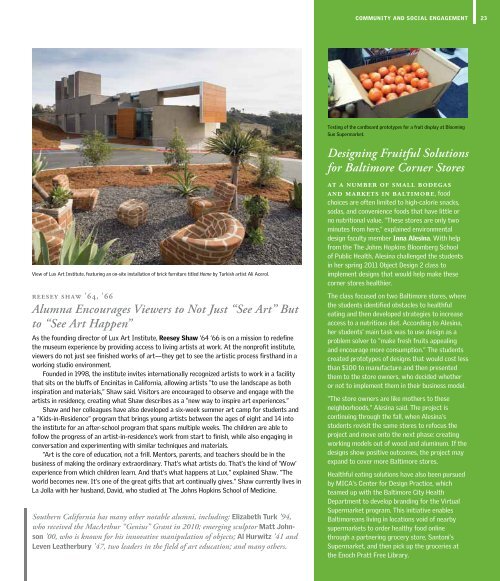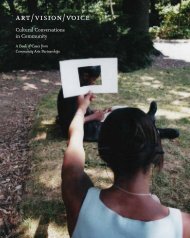Nov.-Dec. 2011 - Maryland Institute College of Art
Nov.-Dec. 2011 - Maryland Institute College of Art
Nov.-Dec. 2011 - Maryland Institute College of Art
Create successful ePaper yourself
Turn your PDF publications into a flip-book with our unique Google optimized e-Paper software.
View <strong>of</strong> Lux <strong>Art</strong> <strong>Institute</strong>, featuring an on-site installation <strong>of</strong> brick furniture titled Home by Turkish artist Ali Acerol.<br />
reesey shaW ’64, ’66<br />
Alumna Encourages Viewers to Not Just “See <strong>Art</strong>” But<br />
to “See <strong>Art</strong> Happen”<br />
As the founding director <strong>of</strong> Lux <strong>Art</strong> <strong>Institute</strong>, Reesey Shaw ’64 ’66 is on a mission to redefine<br />
the museum experience by providing access to living artists at work. At the nonpr<strong>of</strong>it institute,<br />
viewers do not just see finished works <strong>of</strong> art—they get to see the artistic process firsthand in a<br />
working studio environment.<br />
Founded in 1998, the institute invites internationally recognized artists to work in a facility<br />
that sits on the bluffs <strong>of</strong> Encinitas in California, allowing artists “to use the landscape as both<br />
inspiration and materials,” Shaw said. Visitors are encouraged to observe and engage with the<br />
artists in residency, creating what Shaw describes as a “new way to inspire art experiences.”<br />
Shaw and her colleagues have also developed a six-week summer art camp for students and<br />
a “Kids-in-Residence” program that brings young artists between the ages <strong>of</strong> eight and 14 into<br />
the institute for an after-school program that spans multiple weeks. The children are able to<br />
follow the progress <strong>of</strong> an artist-in-residence’s work from start to finish, while also engaging in<br />
conversation and experimenting with similar techniques and materials.<br />
“<strong>Art</strong> is the core <strong>of</strong> education, not a frill. Mentors, parents, and teachers should be in the<br />
business <strong>of</strong> making the ordinary extraordinary. That’s what artists do. That’s the kind <strong>of</strong> ‘Wow’<br />
experience from which children learn. And that’s what happens at Lux,” explained Shaw. “The<br />
world becomes new. It’s one <strong>of</strong> the great gifts that art continually gives.” Shaw currently lives in<br />
La Jolla with her husband, David, who studied at The Johns Hopkins School <strong>of</strong> Medicine.<br />
Southern California has many other notable alumni, including: Elizabeth Turk ’94,<br />
who received the Mac<strong>Art</strong>hur “Genius” Grant in 2010; emerging sculptor Matt Johnson<br />
’00, who is known for his innovative manipulation <strong>of</strong> objects; Al Hurwitz ’41 and<br />
Leven Leatherbury ’47, two leaders in the field <strong>of</strong> art education; and many others.<br />
COMMUNITY AND SOCIAL ENGAGEMENT 23<br />
Testing <strong>of</strong> the cardboard prototypes for a fruit display at Blooming<br />
Sun Supermarket.<br />
Designing Fruitful Solutions<br />
for Baltimore Corner Stores<br />
at a number <strong>of</strong> small bodeGas<br />
and markets in baltimore, food<br />
choices are <strong>of</strong>ten limited to high-calorie snacks,<br />
sodas, and convenience foods that have little or<br />
no nutritional value. “These stores are only two<br />
minutes from here,” explained environmental<br />
design faculty member Inna Alesina. With help<br />
from the The Johns Hopkins Bloomberg School<br />
<strong>of</strong> Public Health, Alesina challenged the students<br />
in her spring <strong>2011</strong> Object Design 2 class to<br />
implement designs that would help make these<br />
corner stores healthier.<br />
The class focused on two Baltimore stores, where<br />
the students identified obstacles to healthful<br />
eating and then developed strategies to increase<br />
access to a nutritious diet. According to Alesina,<br />
her students’ main task was to use design as a<br />
problem solver to “make fresh fruits appealing<br />
and encourage more consumption.” The students<br />
created prototypes <strong>of</strong> designs that would cost less<br />
than $100 to manufacture and then presented<br />
them to the store owners, who decided whether<br />
or not to implement them in their business model.<br />
“The store owners are like mothers to these<br />
neighborhoods,” Alesina said. The project is<br />
continuing through the fall, when Alesina’s<br />
students revisit the same stores to refocus the<br />
project and move onto the next phase: creating<br />
working models out <strong>of</strong> wood and aluminum. If the<br />
designs show positive outcomes, the project may<br />
expand to cover more Baltimore stores.<br />
Healthful eating solutions have also been pursued<br />
by MICA’s Center for Design Practice, which<br />
teamed up with the Baltimore City Health<br />
Department to develop branding for the Virtual<br />
Supermarket program. This initiative enables<br />
Baltimoreans living in locations void <strong>of</strong> nearby<br />
supermarkets to order healthy food online<br />
through a partnering grocery store, Santoni’s<br />
Supermarket, and then pick up the groceries at<br />
the Enoch Pratt Free Library.
















